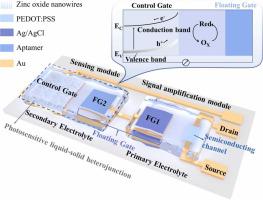当前位置:
X-MOL 学术
›
Nano Energy
›
论文详情
Our official English website, www.x-mol.net, welcomes your
feedback! (Note: you will need to create a separate account there.)
Liquid-solid heterojunction constructing bio-sensory floating-gate OECTs
Nano Energy ( IF 16.8 ) Pub Date : 2024-07-03 , DOI: 10.1016/j.nanoen.2024.109962 Jianlong Ji , Jiahao Liu , Yifei Wang , Fan Zhang , Min Zhao , Sheng Yan , Xiaoliang Guo , Wendong Zhang , Shengbo Sang , Xiaojie Chai , Qijun Sun
Nano Energy ( IF 16.8 ) Pub Date : 2024-07-03 , DOI: 10.1016/j.nanoen.2024.109962 Jianlong Ji , Jiahao Liu , Yifei Wang , Fan Zhang , Min Zhao , Sheng Yan , Xiaoliang Guo , Wendong Zhang , Shengbo Sang , Xiaojie Chai , Qijun Sun

|
The floating-gate organic electrochemical transistor (OECT) employs a distinct signal acquisition and amplification structure. This design offers two primary advantages: firstly, it mitigates the effects of non-specific physical adsorption during the sensing process and prevents contamination of the electrolyte solution by side reaction products, thereby enhancing detection accuracy. Secondly, it allows for an increased gate/electrolyte capacitance, optimizing the OECT’s signal amplification capability. Until now, optimizing the sensing electrode and control gate remains ambiguous. This current research uses a photosensitive liquid-solid heterojunction as the control gate. This choice is based on the observation that the photovoltage of −0.43 V remains unaffected by variations in electrode area, and any reduction in photocurrent due to area reduction can be offset by an increase in light intensity. Furthermore, given that the capacitance value of liquid-solid heterojunctions (4.386×10−2 F) significantly surpasses other components in equivalent circuits during light radiation, these heterojunctions can be considered self-driving and quasi-non-polarized. We confirmed the viability of this structural configuration through cortisol molecule detection. The potential application of this photosensitive liquid-solid heterojunction lies in constructing high-density and high-stability biosensors, a necessity in practical applications.
中文翻译:

液固异质结构建生物传感浮栅OECT
浮栅有机电化学晶体管(OECT)采用独特的信号采集和放大结构。这种设计有两个主要优点:首先,它减轻了传感过程中非特异性物理吸附的影响,防止副反应产物对电解质溶液的污染,从而提高检测精度。其次,它允许增加栅极/电解质电容,优化 OECT 的信号放大能力。到目前为止,优化传感电极和控制栅极仍然不明确。目前的研究使用光敏液固异质结作为控制栅极。这一选择是基于这样的观察:-0.43 V 的光电压不受电极面积变化的影响,并且由于面积减小而导致的光电流的任何减少都可以通过光强度的增加来抵消。此外,鉴于液固异质结(4.386×10−2 F)在光辐射过程中的电容值显着超过等效电路中的其他元件,这些异质结可以被认为是自驱动和准非极化的。我们通过皮质醇分子检测证实了这种结构配置的可行性。这种光敏液固异质结的潜在应用在于构建高密度和高稳定性的生物传感器,这是实际应用中所必需的。
更新日期:2024-07-03
中文翻译:

液固异质结构建生物传感浮栅OECT
浮栅有机电化学晶体管(OECT)采用独特的信号采集和放大结构。这种设计有两个主要优点:首先,它减轻了传感过程中非特异性物理吸附的影响,防止副反应产物对电解质溶液的污染,从而提高检测精度。其次,它允许增加栅极/电解质电容,优化 OECT 的信号放大能力。到目前为止,优化传感电极和控制栅极仍然不明确。目前的研究使用光敏液固异质结作为控制栅极。这一选择是基于这样的观察:-0.43 V 的光电压不受电极面积变化的影响,并且由于面积减小而导致的光电流的任何减少都可以通过光强度的增加来抵消。此外,鉴于液固异质结(4.386×10−2 F)在光辐射过程中的电容值显着超过等效电路中的其他元件,这些异质结可以被认为是自驱动和准非极化的。我们通过皮质醇分子检测证实了这种结构配置的可行性。这种光敏液固异质结的潜在应用在于构建高密度和高稳定性的生物传感器,这是实际应用中所必需的。

















































 京公网安备 11010802027423号
京公网安备 11010802027423号